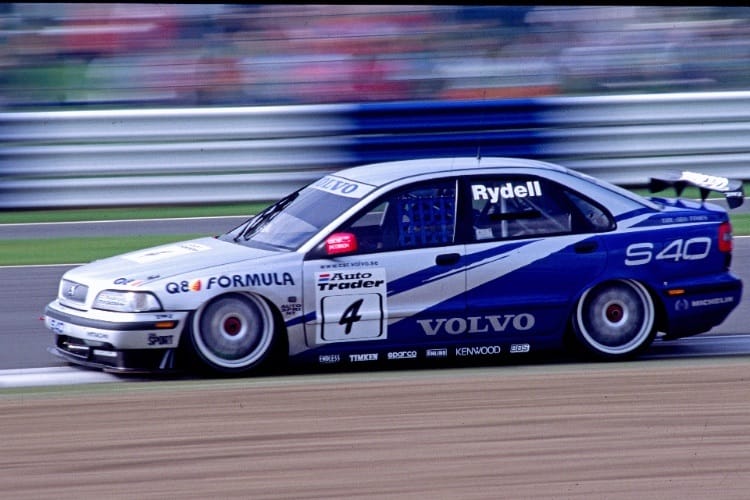Rickard Rydell became a household name in the 1990s thanks to his exploits in the British Touring Car Championship, the pinnacle of which was clinching the title in 1998 at the wheel of his Volvo S40.
However, things could have been so different had it not been for a sudden illness and a phone call from Tom Walkinshaw.
Like many young drivers Rydell began his career in single seaters and had aspirations to join the Formula 1 grid. In the early 1990s the Japanese single seater scene was very competitive and proved to be a good route onto the F1 grid.
“There were quite a few drivers that had gone from Japanese F3000 to Formula 1 like Eddie Irvine, Mika Salo etc, so that was my plan at that time because F1 was not very popular in Sweden,” recalls Rydell.
He had enjoyed considerable success too, finishing third in the Japanese F3 championship and winning the prestigious Macau Grand Prix in 1992, and in doing so adding his name to the likes of Michael Schumacher and David Coulthard who had won it previously. He then went one better in Japanese F3 the following year by finishing as runner up to Tom Kristensen.
“Then I had a spontaneous lung collapse,” he says. “I think it was partly because of stress I guess, at the end of ’93.”
This made Rydell reevaluate his career, the strain it was putting on him and the toll this was taking on his physical health.
“So I had an offer to do F3000 in Japan for 1994 but I got the question from Tom Walkinshaw Racing about the Volvo programme, not directly from Volvo but from TWR. And so I thought commuting to England was better than commuting to Japan because I was living mostly from home in Sweden.
“So when that offer came I thought I had to have a look at it and decided to go ahead with it. And because it was Volvo, I understood it was quite a big commitment from them and everything so it sounded good but I was a little bit reluctant to go into touring cars and leave single seaters so it was not an easy decision from the beginning.”
The fondness and enthusiasm with which Rydell recalls his time in the British Touring Car Championship is infectious, one can’t help but be drawn in as he vividly describes his time in the series.
“The BTCC with all the manufacturers involved was probably one of the most interesting times of my career because you became involved in the development, a lot of testing and I like that. I don’t just like the racing, I like everything behind it, being involved with the engineers, talking about the problems, testing things and learning.
“I really enjoyed that part of it as well. With the British touring cars we were testing all the time.I remember one year I counted my return trips to England or Europe when we were testing. I had like 38 return tickets from Sweden. There was testing every week almost. I really enjoyed it. I enjoyed those years and being with a manufacturer like that.”
Rydell became synonymous with the Volvo brand, competing with the manufacturer for six straight seasons, one of the longest driver-team associations of the Super Touring era of the BTCC. It was one of the most successful too, with 18 victories and a further 37 podium finishes accrued during one of the most competitive eras in the championship’s history.
It all got off to a rather low key start in 1994 though, as Rydell claimed fourteenth in the championship with nine point scoring finishes from 21 races. However, while the results were low key the machinery in which the Swede competed was anything but! Volvo made waves by entering the 850 estate into the championship and it has remained one of the most iconic cars to ever grace the series to this day. However, Rydell doesn’t remember it quite as fondly as many of the fans:
“It was the first time TWR made a front wheel drive car and there was a lot of torque steer on the car. It wasn’t rigid enough, the front and the steering. At Thruxton in the first race, we had to be a metre from the edge of the track because if you hit a bump you might end up one metre to the left or right. The car was really really difficult to drive.
“We didn’t know, neither me or Jan Lammers (his team-mate), what a front wheel drive car should feel like because neither of us had ever driven one. We were complaining a lot, they did make it a lot better.
“After three or four races the car was much better. But still, the estate, being as long as it was, was really slow to change direction so it was a disadvantage if you had a chicane. It was not a good car the first year.
“I qualified third at Snetterton that was the highlight of the year, and finishing fifth a couple of times but that’s probably as good as it could get with the car. If they hadn’t changed the regulations I think they could have made the estate a much better car for ’95.”

The regulation changes forced TWR to switch to the saloon version of the 850 for 1995, and that is a car that Rydell remembers more fondly.
“That car was much much better, I was third in the championship with it, it was definitely a big step ahead. We were really good in qualifying in ’95 because we had the Dunlop tyres which were good on one lap but weren’t as good in the races. They didn’t hold up as good in the races as the Michelin and later on I think we changed to Michelin.
“The car was much much better for ’95 and then they were building on that, the team was getting better and better every year. I guess building on experience and there were new people getting involved with the engineering so they understood more. It was like growing up each year in the technical departments.”
Rydell was third in the championship both in 1995 and 1996, with four wins in each season before the team switched to the S40 for 1997. It was a difficult first season with the car as Rydell only managed one win and finished fourth in the championship but it laid the foundations for the following year which would be the year he finally got his hands on the title.
“I was fourth in the championship in ’97 it was the first with the S40.The car was not really good enough in the beginning so for ’98 we had learnt a lot during ’97. There was a big step from ’97 to ‘98 both on the chassis and the engine. So ’98 was really the year we could do it (challenge for and ultimately win the title). I think it was the test after the winter when we first tested the ’98 car I think we understood (how good it was) because it was a much better handling car than ’97. They managed to change the front I remember, we had less understeer.”
Rydell exploited the machinery at his disposal with a brilliant performance across the whole year delivering 17 podium finishes including five wins, from 26 races to become champion. The year will always be remembered for the thrilling title battle between Rydell and Nissan’s Anthony Reid which went down to the final meeting of the season at Silverstone.
The flashpoint came at Brands Hatch at the end of August, a month before the final round, when in the second race Reid pushed Rydell wide at Druids and slipped through on the inside to take the lead of the race. It would be a lead he wouldn’t relinquish and he crossed the line ahead of Rydell. In parc ferme, Rydell who was normally a very laid back character, angrily confronted Reid, grabbing him by the collar of his race suit before he’d even had time to get out of his car.
Reflecting on the incident Rydell said: “You can clearly see it on the replays when you look at the recordings he wasn’t really braking he used me as a brake he knew what he was doing. He needed to win and he did what he had to do to win and I can understand that.
“I think also by me getting upset and really showing it, helped, because they (the stewards) looked at it very closely and saw that it wasn’t right and he got a few seconds extra and I won the race. I didn’t know that the camera was there at Brands Hatch when I talked to him. I didn’t see the cameraman. I wanted to talk to him before we went on to the podium so I wanted to tell him what I thought. I had no idea the camera was there but my mistake and that cost me £2000.
“I mean I’d rather pay £2000 and get the points which I did. It was a good trade,” he adds with a laugh.
The pair have known each other a long time, having raced together in Japanese Formula 3 in 1992 when Reid became champion.
“We know each other very well. We’re friendly outside. I think he enjoys seeing me and I enjoy seeing him whenever I do. There’s not a problem like that. I think it’s quite normal to get upset in racing. You have to take it as your job and outside is something else. I think if you can’t separate them it’s difficult.
“Let’s say that you can’t separate them and you’re really friendly with your team-mate, then you have a problem when you’re behind him and you need to go past to win the race or win the championship or whatever; you have to separate that. And I think drivers that can’t separate things like that, they maybe tend to stay alone and try not to make friends because they can’t keep that distance if you like.”

After Volvo quit the championship at the end of 1999, Rydell turned down Tom Walkinshaw’s offer of a two year Australian Supercar deal and did one more year in the BTCC with Ford where he was team-mates with the aforementioned Reid, and Alain Menu.
Rydell took three victories to move his total number of BTCC wins up to 21 but he was forced to settle for third in the championship standings behind the pair, with Menu beating Reid by just two points. All three drivers went into the final race with a mathematical chance of winning the title but cruelly Rydell was denied the chance to take the start when his car sprung a leak on the grid, moments before the formation lap.
“We did have a good fight in 2000 with the Fords but both Alain and Anthony had a year of experience with the car. I guess for me it was a little bit difficult in the beginning. I did beat them both in qualifying pace, my qualifying average was quite a bit better than theirs that year but Alain was really good at scoring points when he had to. In the races he did a better job and won the championship.
“It was a pretty good season, I enjoyed it a lot. I was happy with my performance anyway and we were all really close. In the points it wasn’t much. It was fun.”
Rydell was contracted to Volvo until 2003 and so embarked upon a development programme with the S60 and raced it for two seasons in the European Touring Car Championship, finishing fifth in the championship in 2002.
After his contract with Volvo expired he signed for SEAT to race in the ETCC which after a year became the World Touring Car Championship. Again he enjoyed a best championship finish of fifth, in 2008.
Outside of Touring Cars, Rydell describes a career highlight as winning at Le Mans in 2007 alongside David Brabham and Darren Turner.
“To win the GT1 category with the Aston Martin works team was great. I did a lot of the testing in the winter, in the wind tunnel, aero testing and other stuff. So it was really fun to be involved in that project. It was fun to be able to do that.”
After Seat’s withdrawal as a works team from the WTCC at the end of 2009, Rydell took a year out of racing. This proved only to be a sabbatical though as he joined the Chevrolet works team for two seasons from 2011 to compete in the ScandinavianTouring Car Championship. He became champion in his first season and finished a close second to Johan Kristoffersson in his final season.
“It was a very very good championship, I really enjoyed that as well. Doing a championship at home, I hadn’t done that in any of the other years. It was good fun to finish off my career doing two years in Sweden. Winning in ’11 and second in ’12. Those years were really good, especially ’11.”
Rydell made a couple of further cameo WTCC appearances before officially retiring from motorsport in 2016. He now works for Swedish television as an expert commentator on Formula 1 and as a driver coach to Dino Beganovic who is now part of Ferrari’s young driver programme and will compete in Italian Formula 4 this year for Prema.
Although he doesn’t watch the BTCC these days, Rydell does still read about it and is really pleased that it has enjoyed big grids in recent years. He attributes its success to series director Alan Gow, who held the same role when he competed in the championship.
“It needs someone like Alan Gow. I think he did a really good job back then as he is now. You need a strong leader, get everyone to pull in the same direction. He leads everyone the way you want to go and he did that in the Super Touring days.
“Of course everyone can’t be happy all of the time but if you can get everyone on board and pulling in the same way then it’s a good chance that you’ll succeed. Coming back in and doing the same again is quite impressive I must say.”




